Shauna Coxsey or Leah Crane often post photos of themselves training together, traveling together, and competing on the World Cup bouldering circuit together. They seem inseparable. In fact, sometimes, in their perennially popular photo homages to AcroYoga, they appear to be literally inseparable. Their limbs are all intertwined, and you’re not sure where one person’s body ends and the other begins, and it feels like you’re looking at a sort of a two-blonde-headed griffin that’s all muscles and smiles.
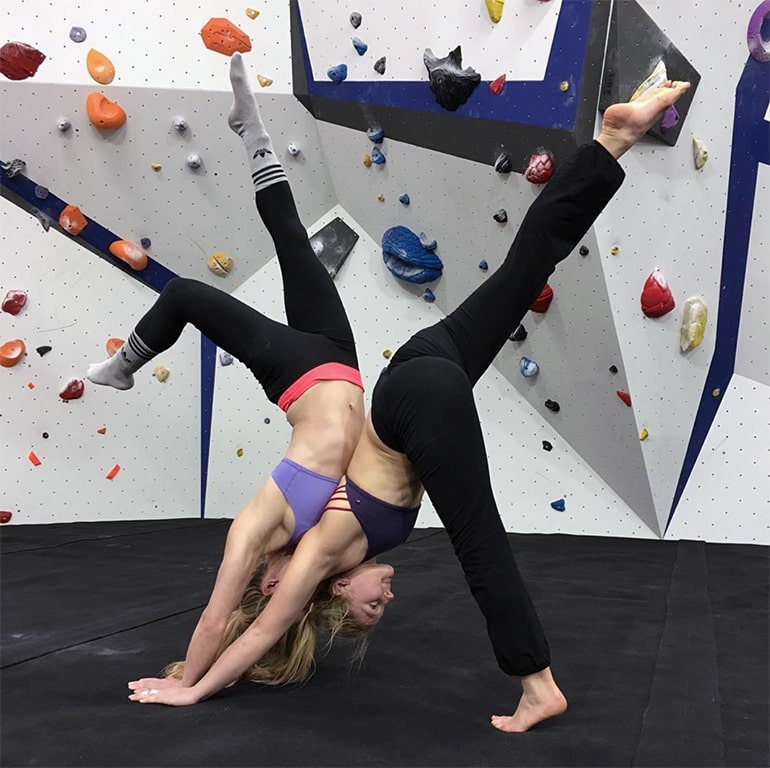
2016 was a banner year for the British Besties. It was Leah’s first year training and competing full time, and she surprised herself by finishing the IFSC World Cup bouldering season in 11th place overall. She was also delighted to make finals in the Adidas Rockstar competition.
Shauna, meanwhile, crushed 2016. She is currently the number-one female boulderer in the world—the result of over five years of dedication and hard work. The grueling competition season, however, ultimately took a heavy toll on Shauna. In Munich, the last World Cup event of the season, Shauna tore her labrum on problem 2 in the finals, still flashed problem 3, but then didn’t perform on number 4. Still, her winning streak over the entire season was enough to secure her a dominant spot as number one in the world.
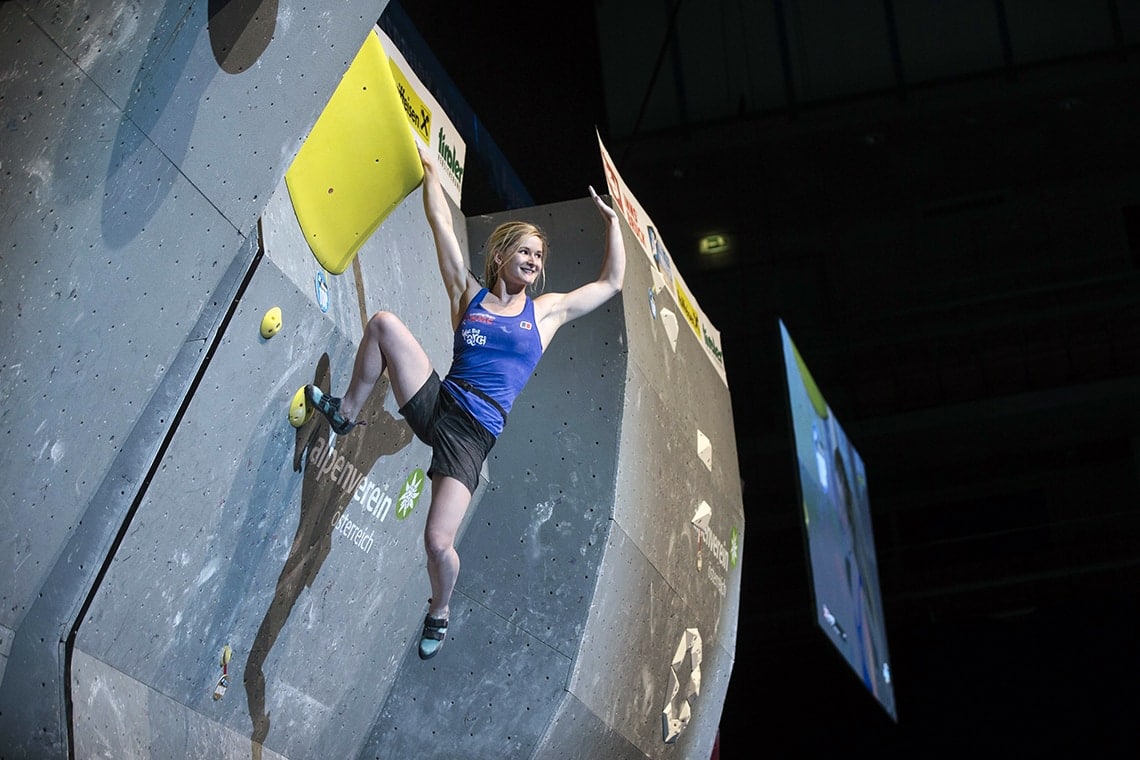
Climbing partnerships, when they’re at their best, are no different than any tight, loving, platonic relationship. What we can achieve when we have a partner to push us past our own preconceived limits is amazing, and Shauna and Leah seem to embody that truth. For the past 15 years that they’ve been friends, these two have found that synergy and it’s taken them around the world and to the top of many podiums.
I got the opportunity to speak to Shauna and Leah on the phone and hear more about their friendship, training, and their famous climbing partnership.
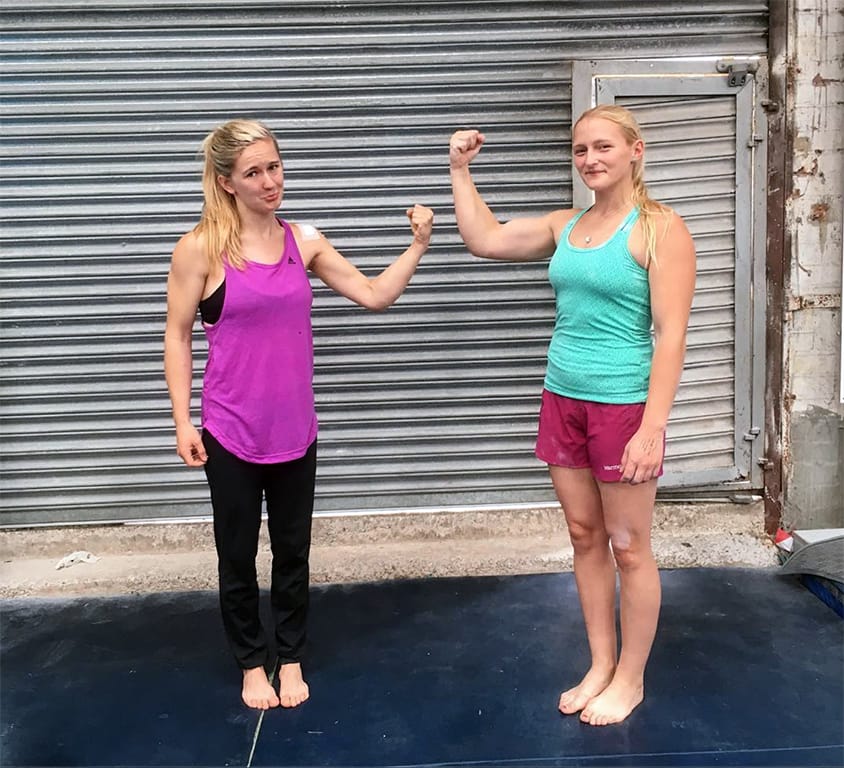
How long have you known each other?
Leah: We have probably been unofficially climbing together since we were really young—maybe10 years old.
Shauna: I was 7 when I first started on the competition scene.
Leah: So about 15 years we’ve been climbing on and off together. We’ve been training full time, really closely together, for the past 2 to 3 years.
Shauna: For me, I really love training with people. I don’t like training on my own so much. I’ll do it if I really have to. Having someone who is motivated and really psyched is really important. And Leah was that person. I realized that, and we started training pretty much full time together and for me it worked really really well. To have someone who was super motivated all the time. Well … not all the time. Sometimes I would be the most motivated, and then other times it would be Leah. For me it was really important to have someone around that pushes me. And Leah’s understanding of climbing is incredible, so she’d be able to help me out with a move and beta and stuff.
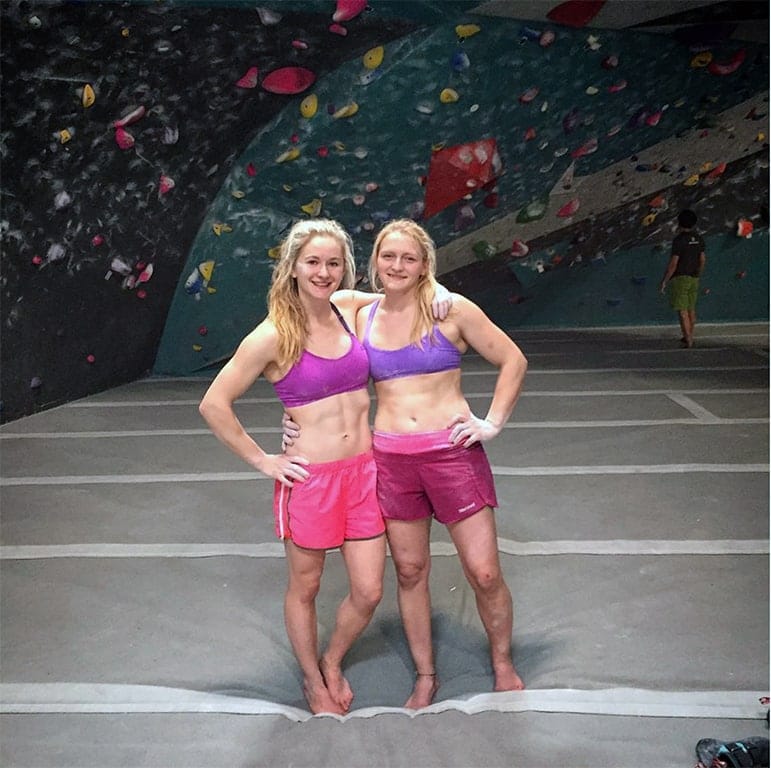
Does it ever get competitive?
Leah:I wouldn’t say competitive is the right word, but we definitely push each other. I think it’s a healthy motivation. From my perspective, getting to train with the number one boulderer in the world has its benefits.
Shauna: I don’t think we are in competition. We’re more like a team. We go to comps as a team. I don’t feel competitive with Leah. If she does something before me, of course, I want to do it, but that could be any guy or any person in the gym—if they do something before me, it’s like, “Oh, it’s possible. Now I want to do it.” If it’s possible for them, it should be possible for me.
Leah:We have different aspirations. My aspirations are at a much lower level than Shauna’s. I think I respect and understand how much better she is in competition than me. And I think that’s what helps keep us on the right side of competitive.
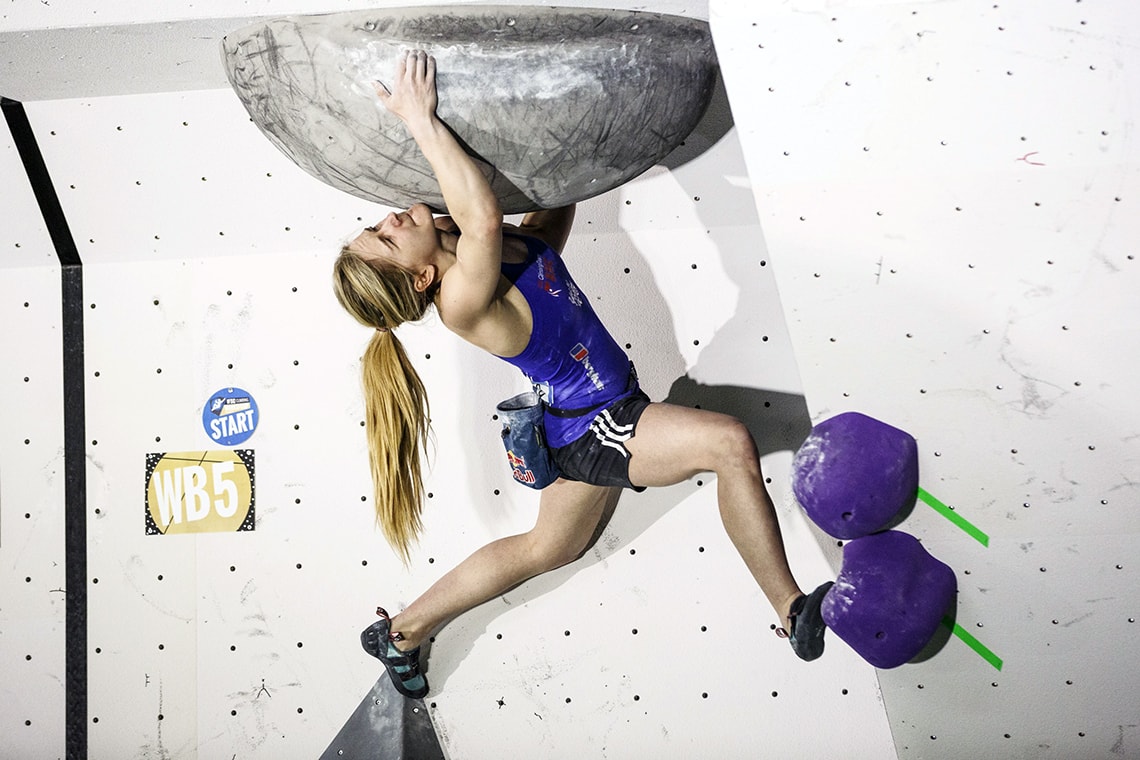
Leah, what is Shauna’s greatest strength and what is one of her flaws?
Leah: [Laughs.] Hmm. Her greatest strength is her stubbornness. She pretty much doesn’t take no for an answer. And if she wants something, she does whatever she has to do to get it. She just pushes and pushes until she succeeds. In the same way, sometimes her stubbornness is also her flaw. Traveling, living, training with her isn’t always the easiest. But I wouldn’t have it any other way!
Shauna: I don’t know how Leah puts up with me.
Leah: She’s very particular about what she wants. She has a forward mindset and nothing is going to get in the way of that. I’m just very accommodating of her.
Shauna: Leah is the most patient friend anyone could ever have.
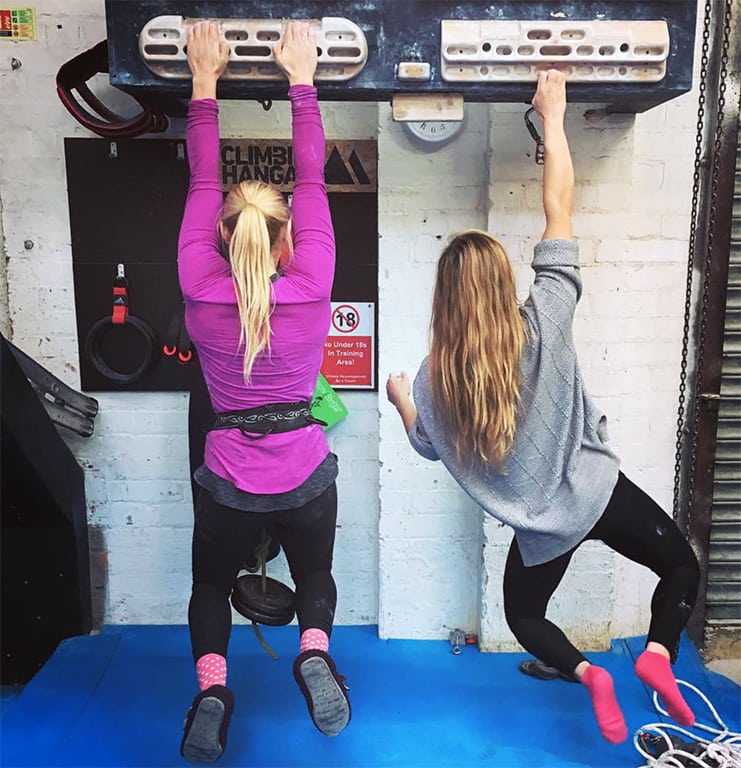
Shauna, same question: What are Leah’s strengths/flaws?
Shauna: Yeah, maybe her patience with me is her greatest strength. [Laughs]. No, in climbing terms, her main strength is her understanding of movement. It’s pretty much more advanced than anyone else I know.
What about a flaw?
Shauna: I don’t know what your greatest flaw would be …
Leah:Probably eating donuts …
Shauna:No, no … I think … let’s see. I don’t understand why people don’t always try as hard as I do. I think I don’t realize how hard I try, and it’s having that extra 10 percent. And I don’t think many people access that. And I know Leah can, and it’s like, maybe not your greatest flaw, but one of your flaws that you don’t try that hard all the time and push yourself.
Don’t get me wrong, Leah tries really hard, but I have to tell her to sometimes. She might fall off a boulder, and I’m like, “Well, of course you fell, you didn’t try hard enough. Of course you’re capable.” And I think I often believe in her more than she does, but I think that’s part of the reason why we train so well together.
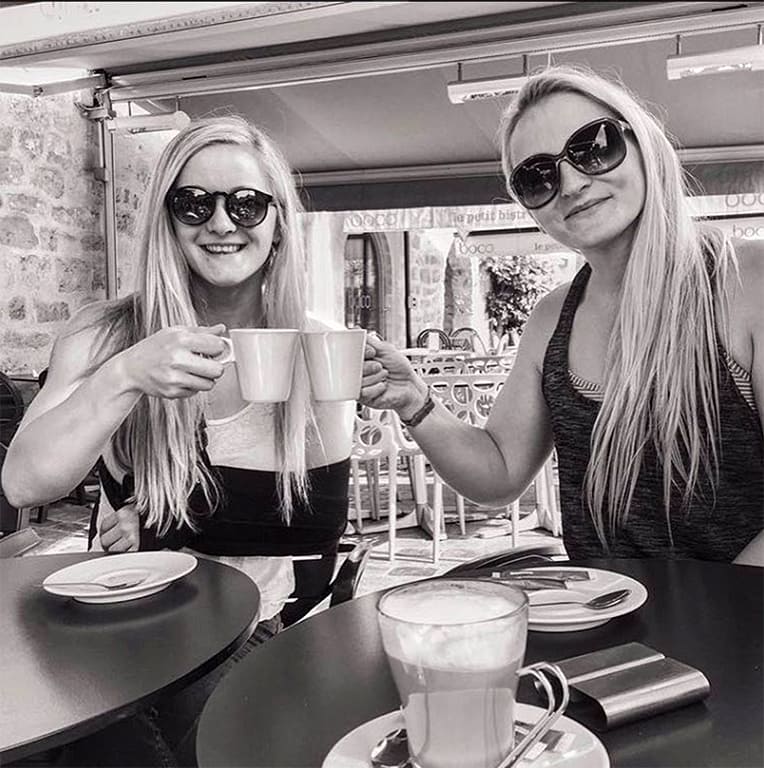
Tell me about your AcroYoga.
Leah: Back in my gymnastics days, I did acrobatics for 12 years at the same time that I started climbing. There was a bit of a craze that started in the UK that was called AcroYoga. Some climbers started doing it and I looked at it and was like, “This is just gymnastics. This isn’t ‘AcroYoga.'”
So one day, I was like, “C’mon Shauna, stand on my shoulders, let’s do some ‘AcroYoga’ and post about it.” Quite sarcastically. This was a joke, really. And everybody absolutely loved it! And I was like, well, this is easy because it’s just gymnastics. And all I have to do is teach Shauna the basic understanding of how to be a gymnast, essentially. And that’s how it started.
We don’t really know what we’re doing, and we don’t know what the proper way of doing AcroYoga is. We’ve never been to a class. We’re just making it up as we go along and it’s the most fun thing you can do pre, mid, or post training session. It just makes you laugh the entire time.

Shauna: Actually we named it “Yogabatics” because we realized people take AcroYoga pretty seriously and we weren’t taking it seriously. For me, learning how to be upside down and do flips was totally insane. Not anything I’d ever done before. Leah would say, “Straighten your legs!”, and in my head, my legs would be totally straight, but I’d look at them and they’d be bent and wonky. So, yeah, I learned a lot about my body but I think Leah and I learned a lot about each other because you have to be quite in tune to trust someone to throw you up in the air and not drop you on your head. Initially I was cautious and quite nervous. But now, if Leah says jump, I say How high?
It’s a good way to build an even closer friendship. I laugh so much doing AcroYoga with Leah that it’s the best core workout I could possibly do as well.
Leah: We do it most sessions to warm-up now because it’s fun.

Leah, what were your highs and lows from your World Cup season last year?
Leah: Last year was my first time training full time. And for me, my high was hitting my goals. My goals were really to go to a competition and actually compete in a semi-final. And when I say compete, I don’t mean get into a semi-final and climb. I mean get into a semi-final and be aiming to start placing high. And that’s what happened for me last season. Placing 11th overall was a bit of a shock to me, to be honest. I didn’t expect to place that high in my first full year of training. Making the finals at Adidas Rockstars was the cherry on top.
The lows? I don’t really think I had one. I guess being away from family, being away from home. My other half, Liam, travels a lot on the ice climbing World Cup, commentating on them. So he’s away for a lot of the winter and I’m away for a lot of the summer. So really it’s missing the people I want to spend time with. … But then I get to spend time with Shauna!
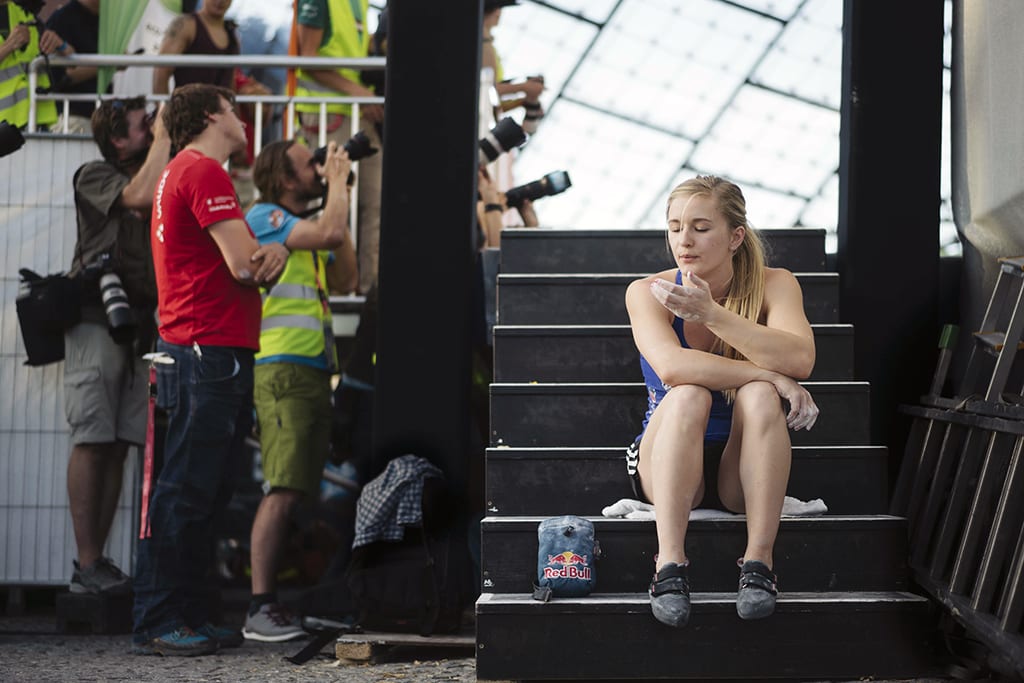
I think people have this impression that life on the World Cup circuit is glamorous—full of travel to exotic locations, like a big vacation. What’s the reality?
Shauna: It’s fun traveling with your best friend. It’s hard to be away from home so much. We literally travel to a country, sit in a hotel waiting to compete, see a climbing wall, and then travel home. We might get a day or two to travel around, but that’s quite demanding and stressful, it can be quite hard at times. I love what I do, but I think it’s not as easy as it may seem to other people on the outside. People seem to think it’s quite a relaxed holiday when we go away. No, not really.
How long does the comp season last, and how much does it cost when you add up travel, entry fees, etc.?
Leah: I’ve never added it up because I don’t want to know …
Shauna: You’ll be gone two to three months away from home traveling. A lot of the Asia comps are back to back. So you’ll fly out to China to get acclimated to the time change. Then stay out in China for the next comp, then go to Japan for the next one. It really does add up. And as far as the cost goes, it’s probably around ten grand.
Any tips for overcoming jet lag?
Shauna: As soon as you get on a flight, start acting like you’re on the time of that country. So, if you’re going to Japan, and it’s bedtime in Japan, then you go to sleep. If it’s not a meal time, you don’t eat. If I get on an airplane and it’s breakfast time wherever I’m going, then I have breakfast and I try to adapt to that time as soon as possible.
I’m also the biggest sleeper. I can sleep anytime, anywhere. If it’s on a flight, and it’s bed time, then I go to sleep.
That’s awesome, I wish I could do that.
Shauna:I think I’m better at sleep than anything. I wish there were competitions in sleeping.
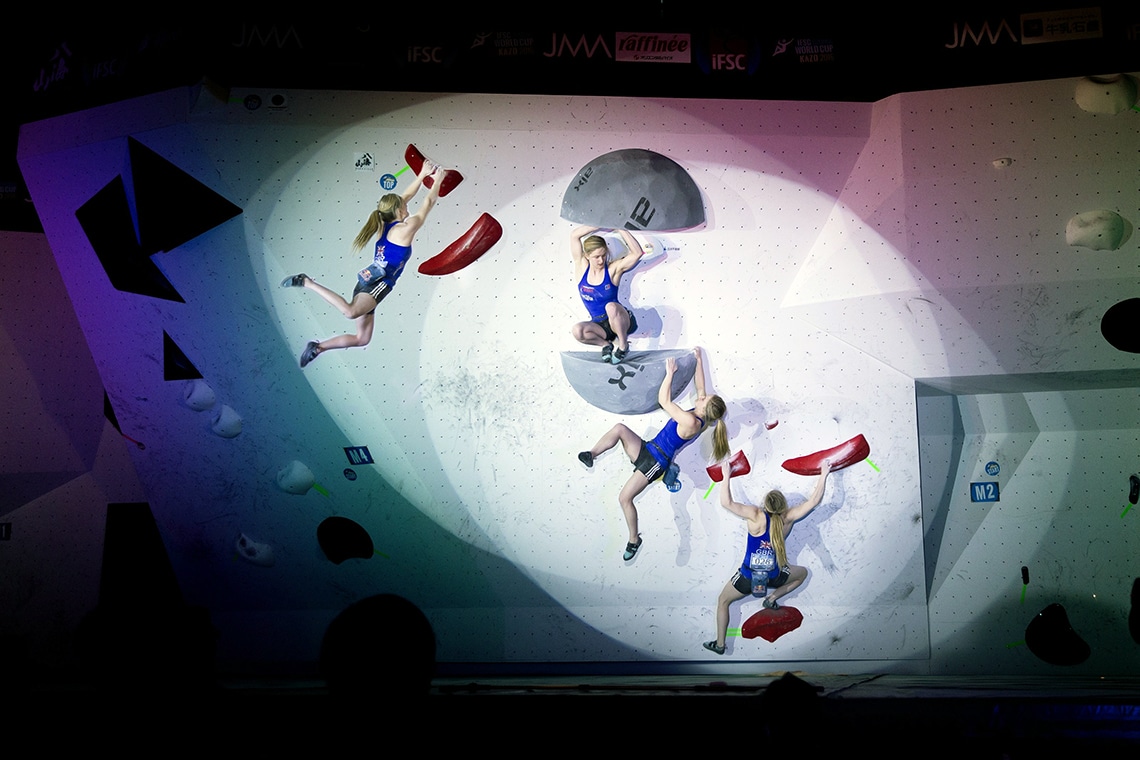
What were last season’s highs and lows for you, Shauna?
Shauna:The season last year went better than I could’ve expected. I worked a really long time to get to the point where I could win World Cups. I’m definitely happy with the season, I wouldn’t change anything.
But you injured yourself, correct?
Shauna: Yeah, I injured myself at the last World Cup of the season. Still, I said I wouldn’t change a thing, and I wouldn’t change that, either. I think I’m a very positive person, which can be annoying at times, maybe. Yeah, but I think injuries are a blessing in disguise. And I’ve learned a lot more about my body than I would have had I not had the injury. And I’m a lot stronger now in different ways. I think injuries are a really good way to come back stronger.
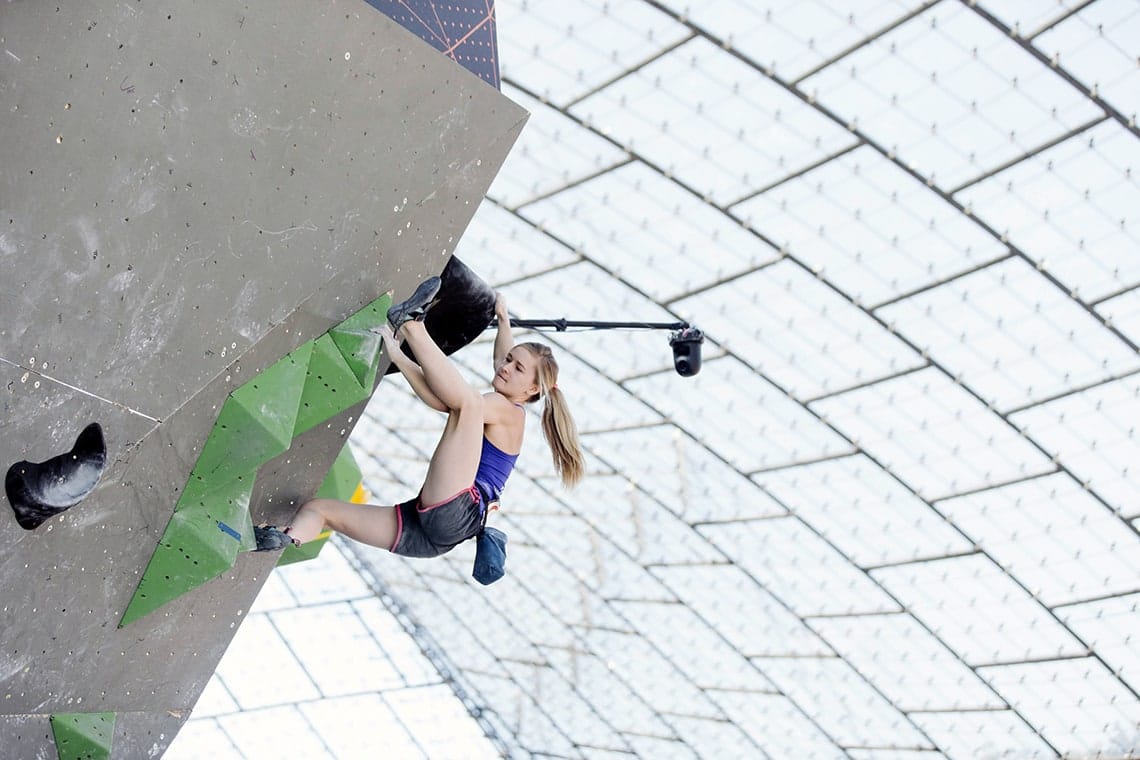
You make injury sound like a really good thing—are you always this positive, or is this all just because you’re being interviewed?
Leah: I can understand why it might sound like she’s just being positive because it’s an interview, but having seen it from the sidelines, with Shauna, everything is always a positive step forward. Everything is about progression. Shauna’s annoyingly positive.
Do you think injuries are inevitable in high end climbing?
Shauna: I think injuries are inevitable in high-end sports … any sport. I don’t think you can name one elite athlete that hasn’t been injured at some point.
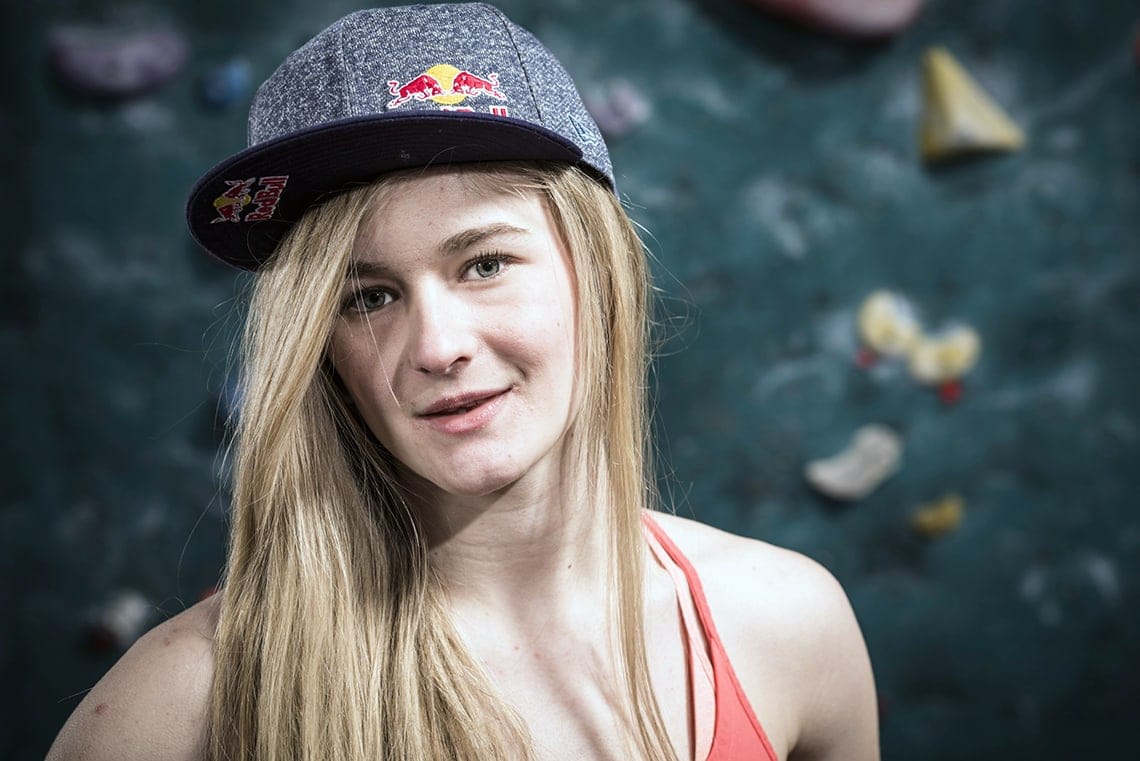
Shauna, I read you and your coach had a five-year plan to start winning World Cups. What specifically did that plan look like?
Shauna: We wrote a five-year plan because I liked having long-term structure. I had goals for each year—training goals. I’m always thinking in the future. When people ask me what my goals were last year, I don’t remember because I’m so focused on what I’m working toward now. What’s next, what’s next?
What exactly do you mean by training goals? Is that, like, going 1-5-9 on the campus board?
Shauna: I don’t go on the campus board ever, but, yeah, something like that. So, it might be something like hanging on the edge of a Beastmaker for 12 seconds with 45 kilos hanging off me. It might be as specific as that. But it could be as vague as not getting as pumped and gaining fitness.
Do you write your goals down in a journal? Where do those goals live?
Shauna: I used to start every season writing my goals in a journal … I have all my old climbing journals as well. I start each year pretty much, or each season, with some goals written down in the back.
But those goals change every year. As I’ve gotten older and gotten more knowledge, the goals have changed, sometimes getting more specific, sometimes getting less specific. This year they are kind of vague because of my injury. I just wanted to be able to go into the World Cups and be satisfied with my performance. For me, it’s less about numbers, especially in bouldering World Cups. World Cup bouldering is not easy to train for. We have to be ready for anything. And so for me to walk away satisfied for my performance, that’s what my aim is.
Do you have a coach?
Shauna: So I’m working with a number of a different coaches at the moment. I work with a strength and conditioning coach. I work with with a finger-strength coach.
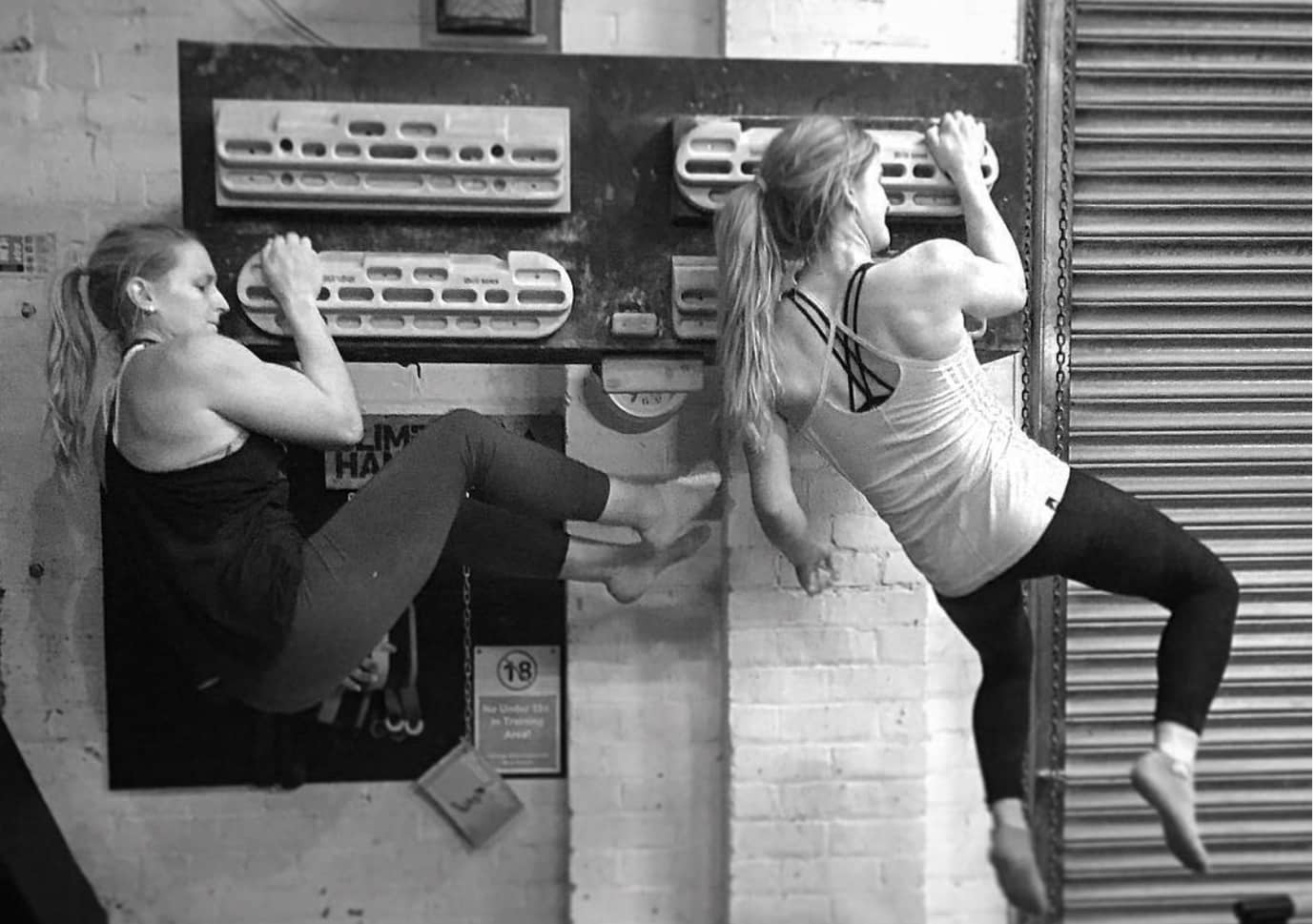
What does a typical week of training look like?
Shauna: I typically train six days per week: four days with double sessions, and two days with single sessions. And those can be anything from 2 to 5 hours per session. And I do three Beastmaker sessions per week. Just working on my finger and arm strength.
I’m climbing probably 75 percent of the time. I do a lot of making up boulders, making up jumps, because I really enjoy that. And sometimes it’s endurance climbing.
My other sessions I’ll go to a fitness gym, to work on leg strength or shoulder stability.
I’m not as strict with a training program anymore. I’ve got a lot more knowledge, and understanding of my body now, so I don’t feel the need for a strict training program day in and day out. But that to me has been vital in the past, but now I don’t feel like it’s as important.
Why?
Shauna: I think it’s important to understand that you evolve. Your body changes and adapts and your mindset does. At this point, I don’t feel like I need as much structure. For me, I need to be climbing a lot and enjoying climbing much more than I need to be putting in the hours on the TRX.
Why don’t you campus?
Shauna: I campus boulder problems, but I don’t campus on a campus board. It’s just more specific, campusing on boulder problems. Campusing is also never been something that I’ve highlighted as a weakness.
Leah: We do a lot of work around shoulder stability. And I think campusing on a campus board is quite linear. Your movement is straight up or straight down. When you start to campus boulder problems, it becomes a lot more about direction and movement and your shoulders being in different positions.
Shauna: And your grip type varies as well, which is important.

What kind of workouts do you do on the Beastmaker? Max hangs? Repeaters?
Shauna: I do a lot of different things. Sometimes I do one-handed stuff with assistance, or with added weight. Sometimes I do two-handed stuff on the smaller edges with added weight, training different grip types: open-handed, half-crimp, full crimp. My boyfriend, Ned, is part owner of Beastmaker. He’s probably the most knowledgeable person I know about finger strength training, so he works with me a lot. I don’t really ask him questions. He tells me what to do and I do it. I trust his knowledge.
How many hours do you sleep per night?
Shauna: When I’m training full time, I need about 10 hours minimum. But I just got a puppy, so I don’t get that much sleep anymore.
What kind of puppy?
Shauna: A border terrier. Arthur.
Do you take supplements? What does your diet look like?
Leah: My diet at the moment looks like not that much fun stuff. I’m in a taper phase for the World Cups at the moment. So I’m taking a longer amount of time to get down to comp weight. A sensible amount of time to lose weight so it’s more maintainable throughout the season.
In terms of supplements, I guess it depends on the training day and how much training I’ve done, but I will take protein every now and then, after a training session, or a BCAA. I don’t really have a strict regime on post-workout nutrition.
What recommendations do you have for losing weight?
Leah: To be honest, I’m doing it freestyle. I find I don’t lose very quickly. I can put on weight extremely quickly, but losing it is much harder for me. In the past, I have what you might call “crash dieted” to get light for a competition. And then, throughout the season, I got heavier than I was when I started. Crash dieting just totally didn’t work for me.
So now I’m going at a much slower pace. I like food. I really enjoy eating. So I’m trying to focus more on portion control, just quantities of food, and making healthier choices, like brown rice or sweet potatoes. Not really detailed rocket science stuff. Just dropping the calories a little bit. I’m not going crazy.
In the competition scene, there’s been a bit of a trend to see your grade going up just by making your waistline as small as possible. That doesn’t work for me, so I’m trying to go slow and steady.
Shauna: Which is different from me.
Leah: Shauna finds getting to comp weight a lot easier.
Shauna: I work with a nutritionist, so we look at skin fold measurements as opposed to weight. They’re looking at the fat more than how much I weigh. Before the season, I drop weight to get to comp weight, and then throughout the comp season I get a bit lighter. Then, towards the end of the year I get heavier again. It’s not massively conscious on my part.
As soon as it’s comp season, my metabolism increases, and I lose weight quite easily. And I can lose weight very fast by just having slightly smaller portions. I love eating, and I don’t mind being a “heavier climber.” I think on the comp scene I’m one of the heavier finalists. But I’m happy there. I feel healthy and strong and happy.
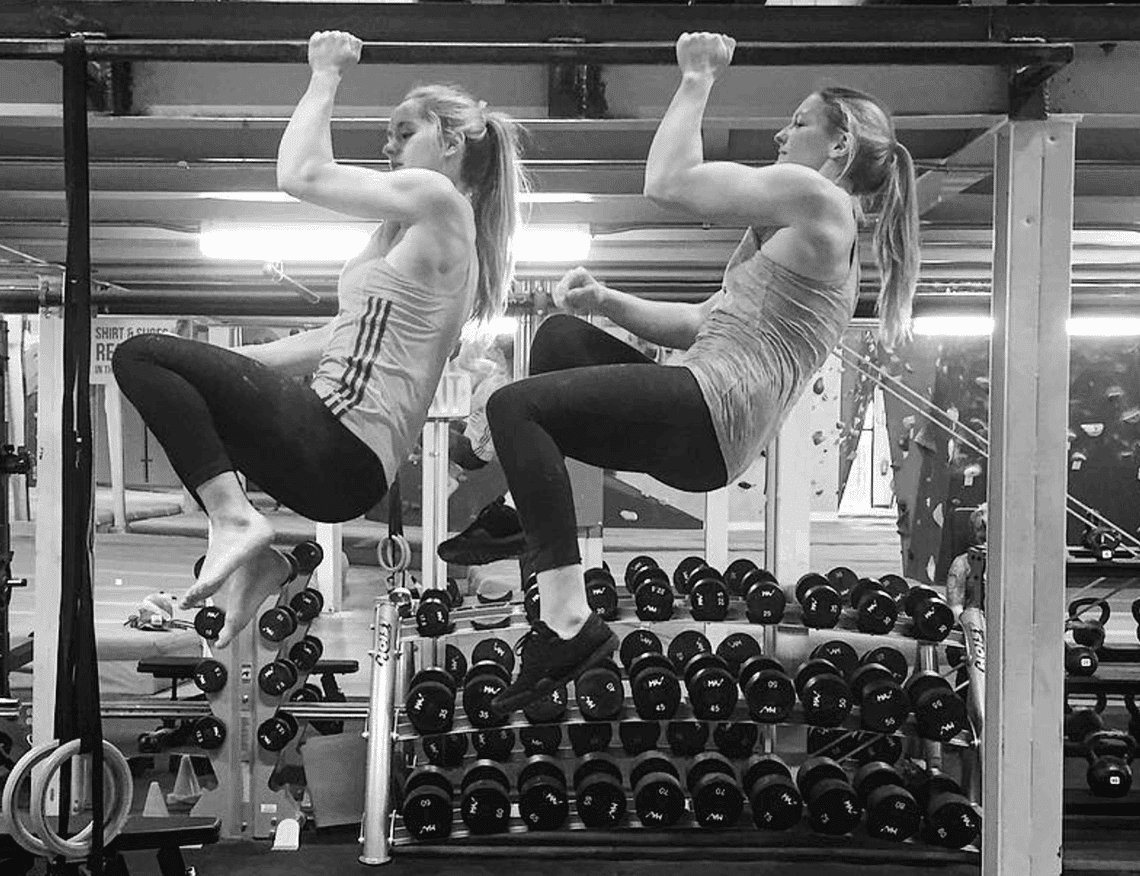
Are you interested in outdoor climbing?
Shauna: Outdoor climbing is something I wish I had more time to put into, but right now my focus is on the World Cups. I want to put everything into it. Outdoors, I have a lot of goals I want to achieve, but I feel like, while I’m motivated and passionate about comp climbing, I should do that. I have a title to defend this year. And I can come back to outdoors at any point.
Tell me about the Women’s Climbing Symposium. What’s the most memorable moment?
Shauna: The Women’s Climbing Symposium is an event I started six years ago with a friend of mine and it’s grown and developed over the years into this massive celebration of this sport. Six years ago, 60 women came to the first event, and I was amazed to see so many women there. This year, six years on, I stood on stage to introduce the day in front of 450 women! That was insane, and one of the most memorable things for me to see 450 women there, psyched out of their minds.
Our goal is to connect, develop, and inspire women in climbing, and they were there to do that. And seeing everyone’s faces totally smiling and totally buzzing from all the information was awesome.
Any final thoughts or message you’d like to share?
Leah: For me, the biggest thing I didn’t realize how much attention people have paid to mine and Shauna’s relationship. Shauna told me that she rarely gets asked anything that has to do with just her—it’s always, How’s Leah? I was quite surprised by that. I guess that I want to leave the message that people should start having a little more fun. It’s important to have a less-serious approach alongside all the more serious approaches. I would say Shauna takes training and being number one really seriously—but she has so much fun along the way. I get to join in on that part.
Shauna: You’re giving away our secrets! People aren’t supposed to know that we’re having fun!
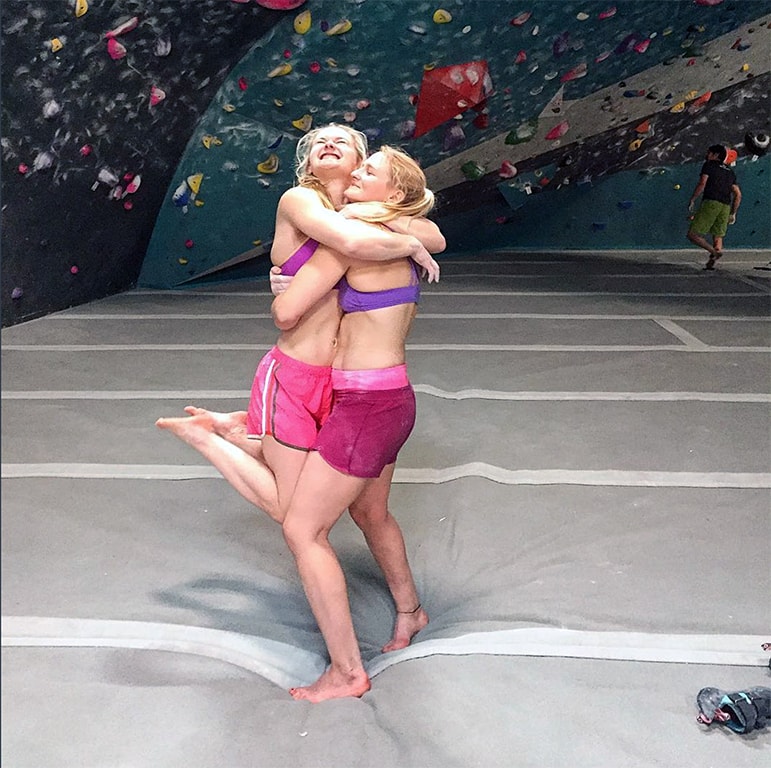

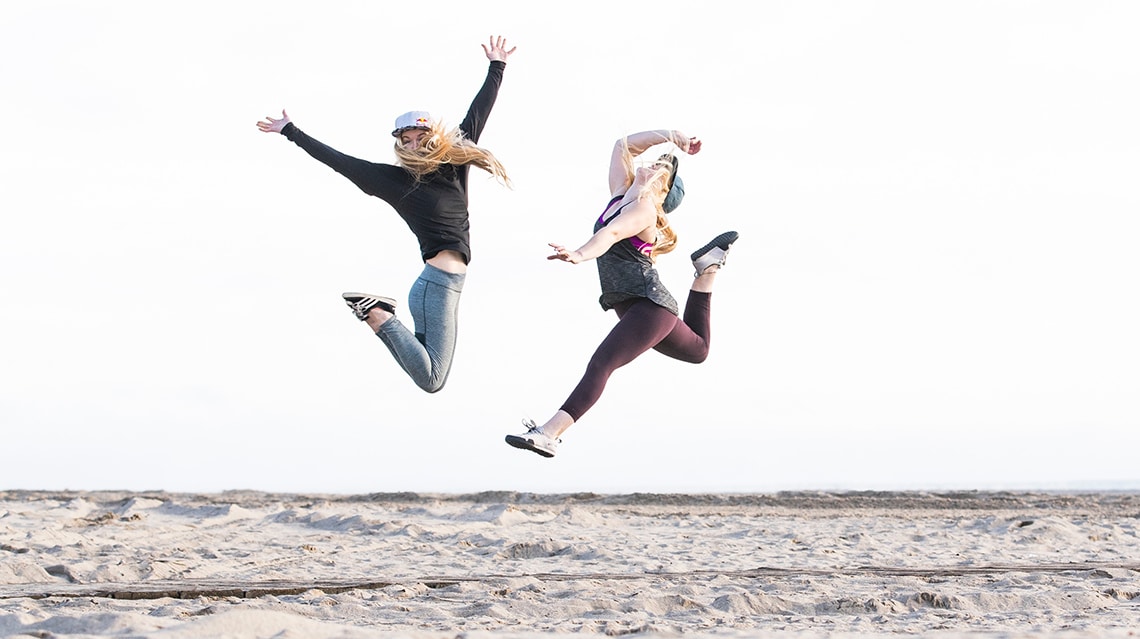


Hi where can I buy a red bull cap like you have ?